
Published date 21st November 2019
I thought after a few years of ownership of Fuji, Nikon and Olympus systems I’d do a small, or possibly not so small, review of them and the pros and cons thereof.
This review is in part specific to the models of camera that I’ve used and is in part generically about the differences between sensor sizes.
There is, inevitably, a huge amount of fanboyism around different manufacturers and misinformation about the benefits of different sensor sizes. I’d like to think I’m a relatively unbiased party here as I own and use all three systems and have bought each system for the specific benefits that it gives me. By the way, I’d love to consolidate to one system, so I don’t have to make a decision on which camera to take with me whenever I go out.
The cameras I own are :- Nikon D750 Fuji X-T2 Olympus E-M1 MKI
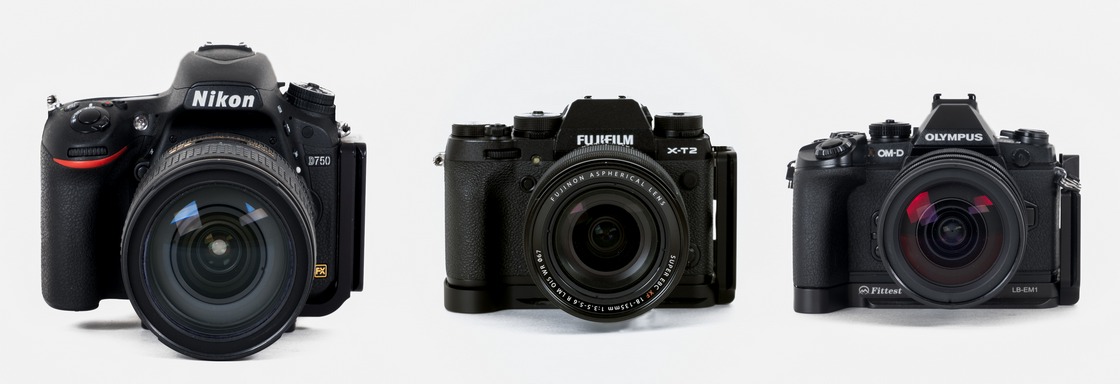
Compared Front View

Compared Top View
First let’s dispel a few myths. Olympus don’t have a big tub of fairy dust that they sprinkle on their sensors that makes them twice as good as the competition. Sony make sensors for Olympus, Fuji and Nikon nowadays so guess what? They’re all going to give the same performance per square millimetre, so more square millimetres mean less noise. So no a M43 sensor isn’t almost as good as an FX sensor with almost 4 times the area.
Second, lens equivalence. I can’t believe this is still a subject of debate. I guess it’s a case of people ignoring or not understanding the maths and facts behind it. Yes Olympus make a 40-150mm f2.8 pro lens, no, it’s not equivalent to a full frame 80-300mm f2.8 lens, it’s equivalent to a full frame 80-300mm f5.6 lens. It gives the same depth of field as a 80-300mm f5.6 lens and lets in the same amount of light as a 80-300mm f5.6 lens. The latter statement is true because three things dictate the amount of light hitting the sensor, shutter speed, aperture and area of the sensor. If we ignore shutter speed for the moment, then yes an f2.8 lens is letting more light in than a full frame f5.6 lens over a given area. BUT the area of the full frame sensor is roughly 4 times greater so the number of photons hitting the sensor, which is what we really care about, is roughly the same as a M43 sensor with an f2.8 lens. So the same thing applies to, say, the Olympus 300mm f4 lens, it’s not equivalent to a 600mm f4 lens it’s actually equivalent to a 600mm f8 lens. And that’s OK, but let’s not pretend it’s something it’s not.
One genuine advantage of faster lenses irrespective of sensor size is improved focusing due to a greater amount of light hitting the sensor, or focusing matrix on a dSLR.
Anyway, having cleared up those two issues let’s move on.
In the photos above the size difference doesn't look massive but don't forget as one dimension grows so do the others, so when the height of a camera is 15% larger than another the overall volume will likely increase as the cube of that 15%, which equates to 50% increase in volume! Anyway, the Nikon D750 fitted with the 24-120mm f4 lens weighs 1700g, the Fuji X-T2 fitted with the 18-135mm lens weighs 1100g and the Olympus E-M1 fitted with the 12-40mm lens weighs 1000g. Those weights are all measured with an Arca Swiss l-bracket fitted, these brackets weigh around 80g so you can knock that weight off if you want. So 1.7kg for the Nikon against 1kg for the Olympus is actually a pretty big difference. I know those lenses aren't equivalent but they are my general purpose lenses for each system. What the Fuji 18-135mm lens gains in length it loses in fast aperture. The Olympus lens, although the shortest of the bunch in terms of focal length is a pro grade lens and is f2.8.
All of those cameras were, when they were released, pretty much top of the line models, with the arguable exception of the D750 which would have been bested by the Nikon D800 at the time. I’ve never been a huge fan of the Nikon Pro camera UI and didn’t like the idea of a heavier body either so opted for the D750.
Which brings me onto another point. One of the reasons I bought the Nikon D750 is because it is 24MP, not 36MP or 50MP or 70MP. Why, I hear you cry, why wouldn’t you want more resolution? The reasons why are:-
Personally, I think that resolution has largely become a marketing tool nowadays, especially for amateur photographers. People like things black and white, resolution is good, so more resolution is better. How about having bigger photo sites that have greater dynamic range? Just saying.
I’ve owned a D750 for 4 years, a Fuji X-T1 for 3 years, recently changed to a Fuji X-T2, and an Olympus E-M1 MKI for a couple of years. So, I’ve had a reasonable amount of hands on experience with all three cameras.
I actually bought the E-M1 second-hand specifically to use for macro photography and it is a revelation in that respect and, in terms of performance, knocks the spots of any dSLR I’ve ever used. The contrast based focusing is as fast, accurate and sure footed a 1:1 magnification as it is at any other focus distance, even in low light (f2.8, 1/8th second for instance). It will also focus bracket very effectively and even focus stack 8 images in body. The latter is the reason I bought it and have used that feature very extensively. The focus stacking can even be used hand-held, although there is a tendency to get a little fringing in the final image when doing this. I think this is due to camera movement shot to shot making the image alignment more difficult to achieve when the camera stacks the images . This phenomenon is often easily removed in post processing though as I’ve shown in a couple of images below.

8 images stacked in camera before editing (notice the slight halo around the top of the mushroom)

8 images stacked in camera after editing (and a little tidying up)
I bought the Fuji X-T1 originally as a lighter weight travel camera. I’m a really keen walker and often go to Cumbria, Scotland, Wales and so on and can walk 13 or 14 miles whilst taking photos. The problem I’ve always had with camera bags is that they’re great for holding cameras, lenses, filters and so on but rubbish for holding waterproof clothing, food and drink. With my Fuji kit I can fit it all in a Domke F-5XB bag which can then fit in my 25-litre backpack along with all my walking gear. That does make it a little bit of a faff to get it out every time I stop but is by far the best solution I’ve come up with to date. All I need now is a rigid, flexible, lightweight tripod that I can slip in my backpack as well. As it is I have to settle for the very good Rollei Gamma 180 (since discontinued), which is excellent but I do have to carry it by hand. On the plus side it can act as a very effective walking pole when crossing streams or other precarious terrain.
I have a Lowe Alpine backpack that I use for my Nikon kit which although it holds a lot it’s not terribly comfortable to walk far with and has no facility for carrying clothing, food or drink.
This has made me realise that the way you use a camera can be quite heavily affected by the way you carry it, i.e. the type of camera bag you have. I really like the Domke F-5XB shoulder bag despite its various shortcomings. It’s small, lightweight and in the waxed canvas finish looks very casual and inconspicuous. Yet I can get my whole Fuji landscape kit in it (21mm to 200mm full frame equivalent) including filters and filter holders and so on.
I do find my choice of camera is now governed more than anything by the lens requirements I have for a specific shoot. I use Adobe Lightroom so I can look back over a given year and see how many photos I’ve taken with each system. One of the great things about Lightroom. In 2019 54% of the photos I’ve taken have taken have been shot of the Olympus E-M1, 40% on the Fuji system and 6% on my Nikon D750. So, despite the Nikon having the superior sensor I’ve used it way less than either of the other cameras. Part of that is because the Fuji and Olympus cameras are lighter, part of it is because I’ve done a lot of macro photography, for which the Olympus is far superior for my purposes, and part of it is that either the Fuji or Olympus camera with a given lens was the better tool for a given job.
One example is a friend asked me to take some photos at his 50th birthday party. The event was in a dimly lit location so the obvious choice might have been the Nikon D750 because of its better high ISO capabilities. I actually took the Olympus E-M1 fitted with the Olympus 12-40mm f2.8 Pro lens. The reason for this decision was because with a M43 sensor and a 12mm lens (24mm full frame equivalent), f2.8 is a very usable aperture in terms of getting enough in focus. If I’d have shot at f2.8 with the D750 then a lot of the image would have been out of focus, which isn’t so good when you’re photographing groups of people. Also, all the Olympus OM-D cameras have amazing IBIS (in body image stabilization) which is far superior to any Nikon lens. That is of limited use when photographing people but does have uses for creative motion blur in some case.
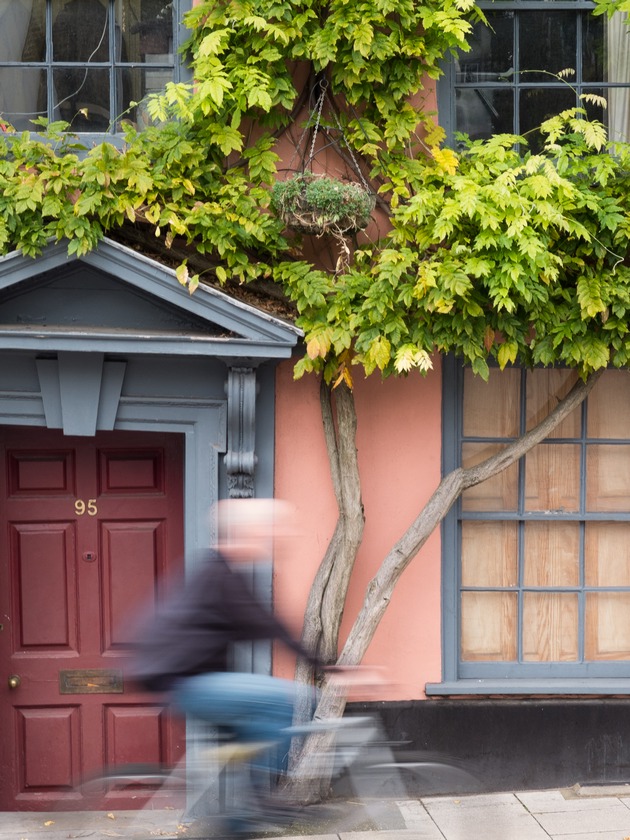
Creative Motion Blur 1/18th second Fuji X10
I’m going to talk at length about each of the camera systems and say what I like and don’t like about each one. I have bulleted the main pros and cons below but you really need to read the intervening text to get a sense of context. But I’ll understand if you want to just cut to the chase and go to the list of pros and cons.
To be honest for a lot of types of photography dynamic range isn’t an issue, I would argue that landscape photography is one of the areas where it matters most. The D750 is virtually ISO invariant (head over to DPreview if you want a more detailed explanation of what that means) which in practical terms means you can expose for the highlights and lift the shadows, a lot, whilst getting very little grain.
Here’s an example where the sun was breaking through and causing very bright highlights on the trees whilst most of the image was still quite dark. The post processed image has been lifted by over 4 stops in Lightroom and as you can see from the final B&W crop there's virtually no noise. You can also see that the sharpness leaves a lot to be desired even on full frame, for whatever reason.
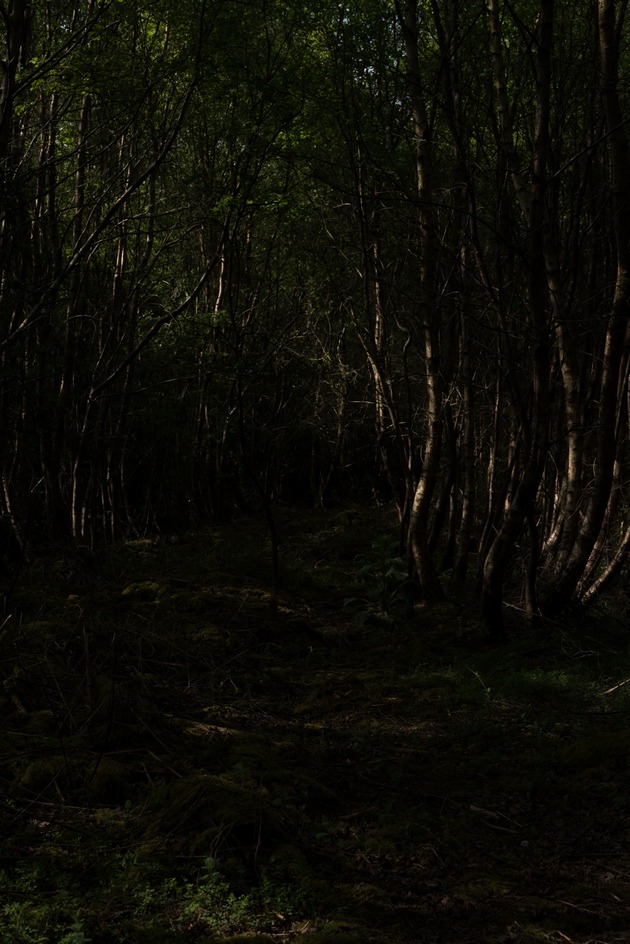
D750 Dynamic Range Before Processing

D750 Dynamic Range After Processing
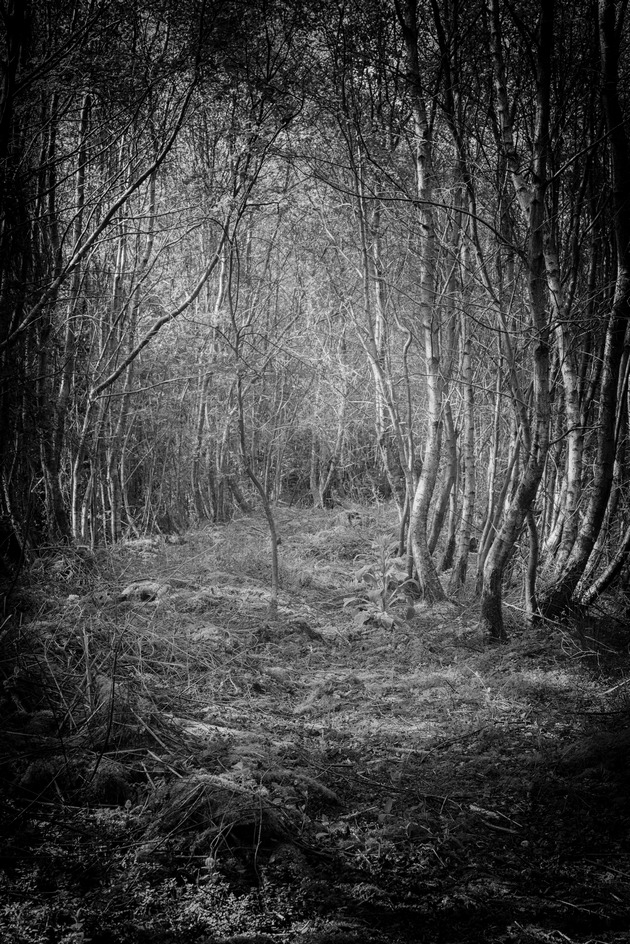
D750 Dynamic Range B&W

D750 Dynamic Range Crop (58mm, f11, 1/100th)
Yes I could have used HDR/exposure blending in this instance but that’s not always so easy when you have movement in your scene.
Fuji ergonomics are very much a matter of taste. Yes, lots of dials can give a very engaging experience but they do preclude having custom presets that allow you to redefine the state of the camera at the flick of the command dial, something that both the D750 and E-M1 do allow. Whether this affects you rather depends on what sort of photography you do and what sort of experience you want from your camera. Some would argue slower is better sometimes.
I can mostly live with it although I do prefer the Nikon and Olympus approach. However the Fuji system does make things slower and more deliberate, which can be good.
A slightly annoying feature of both the X-T1 and X-T2 is that if you want a real 1:1 preview on the back of the camera then you have to shoot in JPEG as well as RAW. The raw files must have lower resolution JPEG images embedded in them because if you zoom in on the camera with a RAW file then you get nowhere near 1:1 so you can't really check whether you nailed focus or not.
One thing that is a delight on the X-T1 and X-T2 is the functionality when using ND1000 filters. On a dSLR you have to frame, focus, expose, set everything up and then set everything to manual before putting the ND1000 filter in place because you can't see a damn thing through the viewfinder. With the Fuji X-T1 and X-T2 you just carry on as normal, you still get a viewfinder image, albeit somewhat grainy, amazingly the camera can still focus in daylight with the ND1000 filter in place! This does make things a lot easier. If the shutter speed exceeds 30 seconds then you do have to calculate it manually because the camera won't do that for you.
One of the big advantages of the Fuji X-T2 over the X-T1 is that you can set shutter speeds down to 15 minutes in T mode. The X-T1, annoyingly, only allows 30 seconds. This was one of the reasons I changed to the X-T2. Another reason was that it has twin SD card slots. I much prefer to write everything I shoot to two SD cards just in case one fails. I do know someone who had he done this could have saved himself several hundred pounds trying, unsuccessfully, to retrieve critical images from a failed hard disk.
I've also used an ND1000 filter on the Olympus E-M1 in fairly bright daylight and it works just as well as the X-T1 and X-T2. I believe the E-M1 limits to 60 second shutter speed at the longest which could be limiting as I often shoot exposures of a couple of minutes or more when photographing water. I know you can always resort to Bulb mode but that means having some sort of external shutter release which I prefer not to do.

Fuji X-T1 99mm f11 1/6 second

Fuji X-T1 25mm f5.6 30 seconds
For me it’s the dynamic range and the ergonomics that make the D750 an attractive camera not the ability to shoot at high ISOs with little noise. I had a look in Lightroom at the photos I took last year and only 3% of them were taken at an ISO of above 400 and they were virtually all at the evening event I mentioned earlier. If you shoot high speed indoor sports, then there is simply no substitute for a full frame sensor so you can shoot with a higher shutter speed at high ISO and still get usable results. But that’s a pretty niche area of photography that most of us don’t do. In many situations, if you’re not photographing moving subjects, then class leading image stabilization is a fantastic thing to have, and that’s what Olympus have, in body, so you get it with all your lenses, even fast primes.
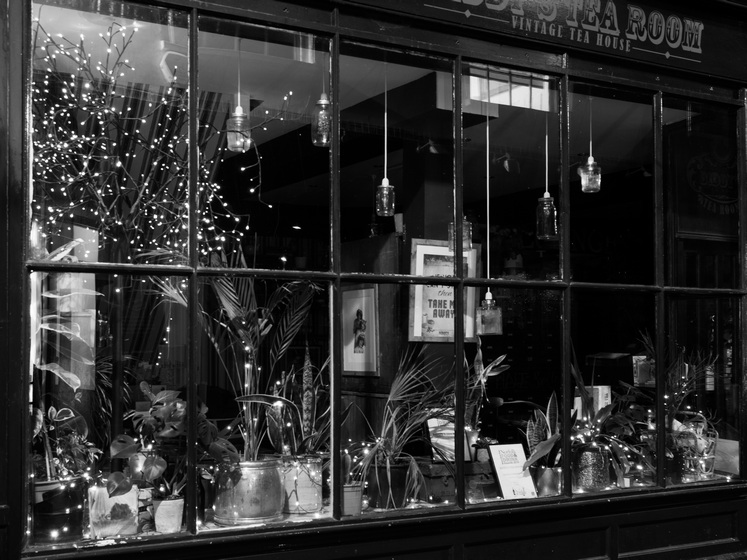
E-M1 Hand-held (21mm, 42mm Fx, f4, 1 second, ISO200)

E-M1 Hand-held Crop (21mm, 42mm Fx, f4, 1 second, ISO200). Not razor sharp but pretty damn good.
The E-M1 allows me to shoot at 1 second hand-held, I don’t believe any other system does that. For static subjects that means you can almost always shoot at 200ASA whereas on a full frame camera you’d probably be shooting at 1600ASA. Olympus claim you can hand hold up to 5 or 6 seconds if you have one of their newer image stabilised lenses that work in harmony with the IBIS in the E-M1 MKII and E-M1 MKIII and I have no reason to doubt this claim from what I’ve seen. That really is quite transformative if you think about it. You can now go out at night without a tripod and still be able to photograph pretty much anything, as long as it's not moving.
This does lead me onto another rant. If I were trying to design the ultimate camera I’d look at all of the competition, see what they do well and cherry pick all of the best user interface features and combine them together into one amazing camera. Does anyone do that? No. I’d argue that ergonomically the Nikon D750 is the best camera of the bunch here. The reasons I say that is because it has custom presets, which allow you to store any aspect of the camera’s setup and recall them at the turn of a dial. It has a properly designed custom menu into which you can add any setting of the camera and call the whole thing up with the press of a designated function button. I’m sure most people don’t use this but it’s a complete revelation if you do, no longer do you have to wade through endless menus to find what you want. You just cherry pick the 10 or 12 menu items you use regularly and put them in the custom menu, simples! But does anyone else do this? No. Fuji have a custom menu on the X-T2 and it’s typical Fuji in that they know best and only offer the user such a useless subset of menu items that there’s frankly no point in having the feature at all. Would it really have been so hard to have done it properly? The E-M1 doesn’t even have a custom menu, I don’t beleive one has been added on the E-M1 mark II either although the E-M1 mark III has final got one. I can't comment on how well or otherwise it works.
One minor point I would comment on, on the D750, is that although the custom menu implementation is very good indeed for some reason calling it up with a function button can be preceded by a really annoying delay of about 2 seconds. I've no idea why this is, it might be the camera coming out of sleep mode, into which most dSLRs go very quickly. Either way it is annoying and it would be nice if it didn't do it.
The E-M1 does have 4 custom presets, unlike Nikon’s 2 custom presets. This is very good, not least because the functionality of the E-M1 is so great that the requirement for custom presets is that much greater. I have one set for focus stacking and one for focus bracketing at the moment but if I shot sport or nature I’d probably have another one dedicated to that. The UI (user interface) allows you to tie the presets to any of the settings on the command dial that you wish. The only thing I don’t like about these presets is that if you select one and change the aperture for instance then turn the camera off and back on, everything is reset, so the aperture goes back to whatever the initial stored value of aperture was. Nikon keep any changes you’ve made to the preset state until you select another setting from the command dial. All personal preference I’m sure but I do prefer Nikon’s way of doing things, I find it more intuitive, YMMV.
Another thing that Nikon do well that no one else comes close to is the Nikon picture control utility. This allows you to import a photo into the picture control utility on PC, adjust it the way you want it on a colour calibrated monitor, including B&W conversion and tone curve and then save the preset you’ve created back to the camera. This is great if you want a really strong B&W conversion, for instance, that you can see though the viewfinder on a mirrorless camera. Neither Fuji nor Olympus have anything like this. Fuji allows you to adjust highlights and shadows in camera, but this is a relatively blunt tool in comparison to Nikon’s solution. Olympus have any number of predefined effects one of which happens to be a high contrast B&W but what you get is what you get. I find having had a better solution with one camera it’s always slightly galling to have to settle for an inferior solution with a different camera.

Olympus E-M1 high contrast B&W processed in Lightroom
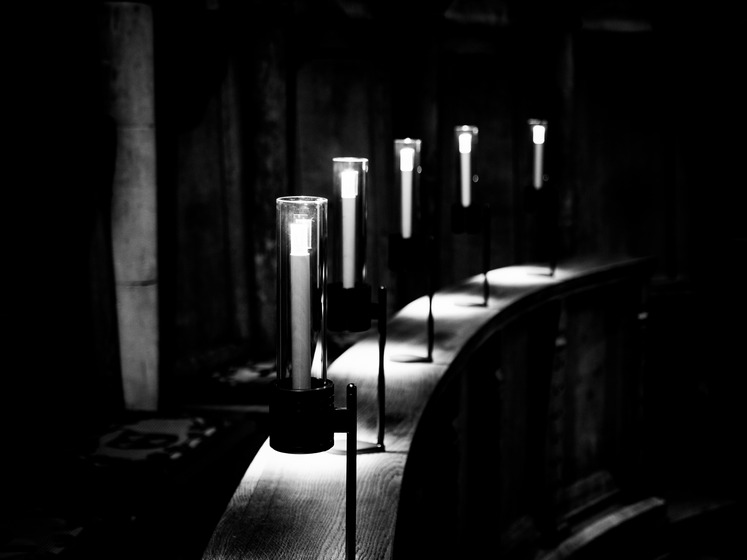
Olympus E-M1 high contrast B&W processed in Lightroom
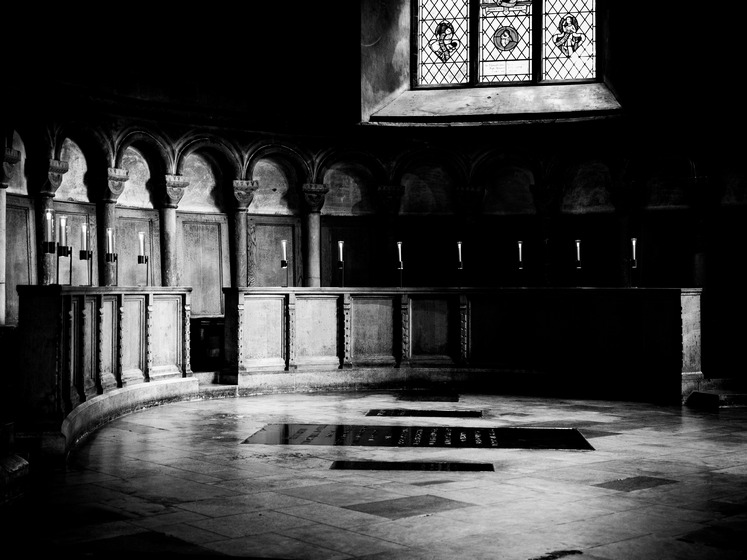
Olympus E-M1 high contrast B&W processed in Lightroom

Olympus E-M1 high contrast B&W processed in Lightroom
The photos above were processed in Lightroom to give this high contrast effect but I did shoot RAW and JPG with Olympus's grainy B&W so I had a reasonable idea of what the I was likely to get when I looked through the viewfinder.
Something that does frustrate me on the E-M1 is, what I consider to be, the appalling auto ISO implementation. I always shoot in aperture priority so I can control aperture whilst wanting the camera to take care of shutter speed. I really don’t know what they were thinking when they came up with this. The Olympus auto ISO does not allow you to set a minimum shutter speed WTF!? It determines the shutter speed from the lens focal length, so a 12mm lens will give you 1/24 second. Why? What were they thinking? Olympus have the best in body image stabilisation in the industry but suddenly when you select auto ISO that counts for nothing, they suddenly pretend it doesn’t work at all. Also, if shooting something like sport or birds in flight you will probably want to set a high enough shutter speed to freeze motion irrespective of your lens length. I guess they assume you’ll always be in shutter priority, which most people probably are when shooting moving subjects. But I personally find this shortcoming pretty unforgivable, just because it would be so easy to do it properly. I think they have made a vague effort to sort this out in the Pen F, in that I believe you can actually set a minimum shutter speed in Auto ISO. That being the case, why the hell have they not rolled out the change via a firmware update to all their other cameras?
Not wishing to keep referring back to Nikon but they implement auto ISO properly. You can set a specific shutter speed or have the shutter speed related to the focal length of your lens and you can weight the focal length related shutter speed 2 stops in either direction to allow for image stabilised lenses or too much coffee consumption in the other direction.
I think it’s fair to say, from my point of view at least, that Nikon’s 100 years or so of experience in making cameras does show in that they really have paid a lot of attention to the user interface in a way that Fuji certainly haven’t and in a few areas Olympus don’t quite measure up to.
In defense of Olympus and the E-M1 the UI is very highly customisable and is very good indeed in most areas. What I would say though is that I know people who've been scared off from the OM-D cameras because they were too complicated to use. So you must accept that you'll need to invest a fair amount of time and effort when you first get your camera to get it setup the way you want it. Unfortunately on the E-M1 mki you can't save your camera state and customisations so you can load them back into another camera or load them back in after doing a major firmware update.
Talking of firmware updates, I absolutely hate the way Olympus handle firmware updates. I think it's truly awful. With Nikon and Fuji you download the firmware off the internet, copy it onto an SD card, start the camera up and do the firmware update. With Olympus you have to connect your camera to your PC whilst it downloads the firmware and then updates it. You have no control of the process, so if you were to get a firmware update that was unsatisfactory for some reason you would be unable to down grade to the previous version.
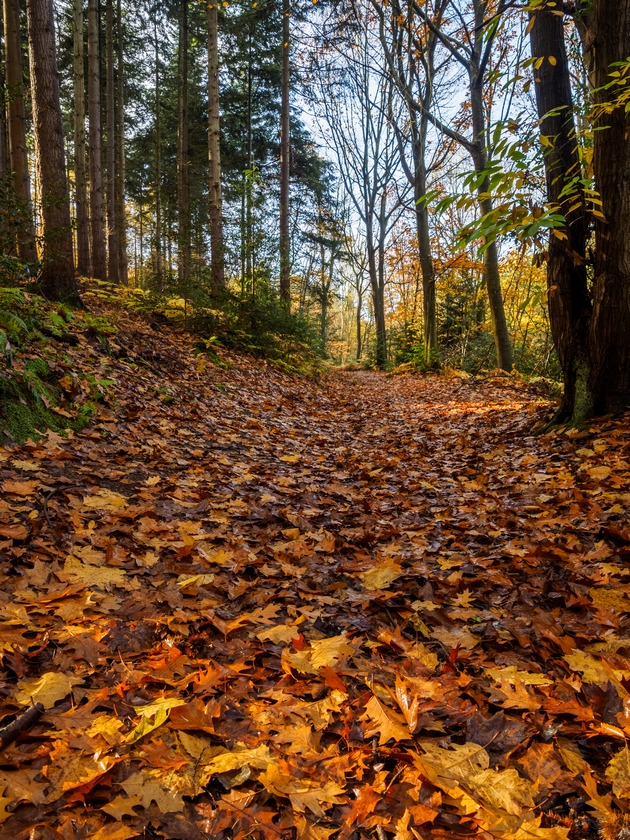
Olympus E-M1 12mm hand-held HDR
Anyway back to the Olympus UI. Olympus allow you to directly select various bracketing options, 3 shots at 2 stop spacing, 5 shots at 1 stop spacing and so on. This makes it very easy to just switch the camera into a hand-held HDR mode and back out again. I had to dedicate one of the 2 custom presets to do that on my D750. To Fuji’s credit you can just click the shooting mode dial around to bracket on the X-T1 and X-T2 to do the same thing so there’s a very workable solution on all of the cameras.
One of the down sides of Olympus’s approach is that certain things end up grouped into categories that make them mutually exclusive. Such as focus stacking or bracketing and self-timer delay. I generally prefer not to have to use remote camera releases, they’re another thing to carry, they get in the way and you have to breach the camera’s weather sealing to plug them in. So, I’ve always used the self-timer set to a couple of seconds. On the E-M1 you can’t do this when using focus stacking or focus bracketing mode. Not that serious but annoying none the less.
There is of course the old chestnut of battery life, and yes of course it is worse on mirrorless cameras but it’s really not a big deal for most people, just carry a couple of spare batteries. I’ve never needed more than two batteries in a day of landscape photography using the X-T2. I do wonder how much of an issue this would be for nature photographers though who have their cameras turned on all time they’re shooting so they don’t miss anything. I can imagine you might get through a few batteries in a day doing that. What I would say though is I have taken 1600 photos on a single charge with my E-M1 and that's using a 6 year old battery. So you may find mirrorless camera have much better battery life than you expect. It certainly shows that the CIPA quoted figures are largely meaningless in a real world context but they may well give a relative comparison between cameras.
Another issue with dSLRs that many of you may be familiar with is that the focusing mechanism is a separate entity to the sensor so there can be a discrepancy between the two which means your photos end up not being focused where you think they should be. This is only really relevant with fast lenses where you have a very shallow depth of field. I've only really had issues with this on third party lenses. One particular instance I've seen is with a Sigma 150mm f2.8 macro lens. This is an old but excellent lens which is as good for portraits as it is macro but it consistently focuses slightly off from the point where it should be focusing and trying to trim it in with the fine focus on the camera doesn't work because the focus error changes depending on focus distance. One of the benefits of mirrorless cameras is they should never suffer from this issue because they're focusing directly on the sensor.
I guess that brings us on to lenses. As ever I think the D750 is ultimately the winner here if you’re prepared to spend enough money on your lenses. I use the Nikon 24-120mm f4 lens rather than the Nikon 24-70mm f2.8 because it’s smaller, lighter and a more flexible range of focal lengths but there are places where it’s not so sharp, wide open at anything above 50mm for instance. So as ever sharpness is dependent on just how much weight you’re prepared to tolerate and how much you’re prepared to spend.
| Sensor type | Fx | Dx | M43 | So called 1" |
|---|---|---|---|---|
| Sensor width | 36mm | 24mm | 17mm | 13mm |
| f2.8 | 384MP | 171MP | 96MP | 50MP |
| f4.0 | 192MP | 85MP | 48MP | 25MP |
| f5.6 | 96MP | 43MP | 24MP | 12MP |
| f8.0 | 48MP | 21MP | 12MP | 6MP |
| f11 | 24MP | 11MP | 6MP | 3MP |
| f16 | 12MP | 5.3MP | 3MP | 1.6MP |
| f22 | 6MP | 2.7MP | 1.5MP | 0.8MP |
Then there’s diffraction to deal with. I’ve included a table above showing diffraction limits for different size sensors. This shows you really don’t want to be shooting your 48MP full frame behemoth at anything over f8 or diffraction is crowding in on you and lowering your resolution. You can see the weakness of M43 here. If you were using the Olympus HiRes function on some of the newer cameras you really wouldn’t want to shoot above f4!
But of course, there’s more to life and photography than sharpness. I’ve seen lenses that have been all but unusable due to chromatic aberrations, the Panasonic 20mm f1.7 springs to mind. Maybe I was unlucky and got a bad copy but that lens was so awful that correcting the chromatic aberrations in post processing caused significant other aberrations to manifest.
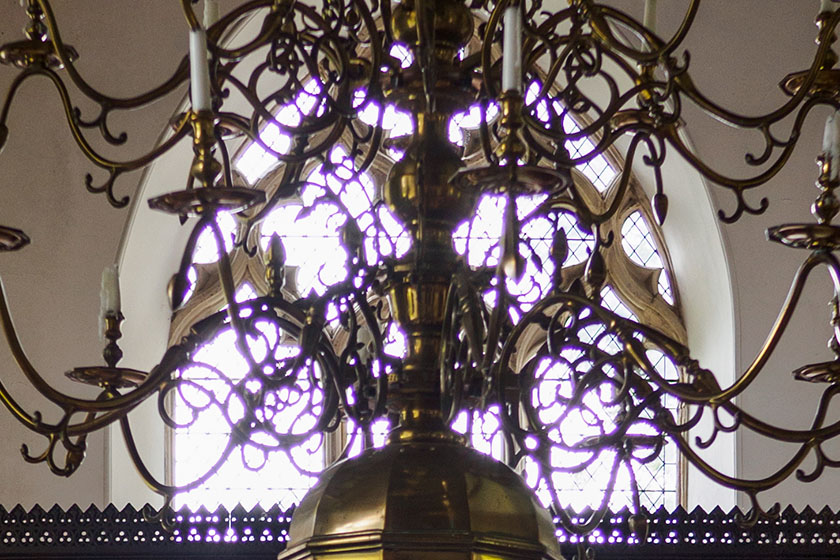
Panasonic 20mm f1.7 Chromatic Aberrations
Flare is another insidious problem that can manifest as reduced contrast and bloom (glowing of light areas into darker areas) as well as large coloured blotches. I have found the Olympus 12-40mm lens to suffer quite badly from this on the E-M1 body. I have seen a few comments on the internet that suggest this may be body dependent. Having tested it with a different Olympus body it was no better though so I don't believe that's actually the case. I would say my copy of the 12-40mm lens on my E-M1 flares so badly that you can’t really photograph with the sun in the frame. This is by far the greatest weakness of this lens as it’s very good in every other respect. It’s pretty much as sharp as the 16MP sensor across the frame at all focal lengths and all apertures until diffraction limits it. Notably, the Fuji 18-135mm lens is much better at controlling flare than the Olympus 12-40mm.

Olympus E-M1 flare (16mm, 32mm Fx, f11, 1/100th second ISO200)

Olympus E-M1 flare (27mm,54mm Fx, f7.1, 1/1000th second ISO200)
One of the things I do like about the Olympus 12-40mm is that being 12mm at its wide end it’s quite viable to shoot it wide open at f2.8 in low light and still pretty much get everything in focus. This is the benefit on M43 over full frame. Sometimes, despite what you might read on the internet, you actually want more depth of field not less.

Olympus E-M1 all in focus at f2.8 (12mm, 24mm Fx, f2.8, 1/40th second ISO200)
Which of course brings us on the that other favourite of the full frame brigade, depth of field and that you have to have full frame to get a shallow depth of field. This is of course a huge generalisation and largely untrue. I own a Mitakon 35mm f0.95 lens which is a remarkably good lens. It equates to a full frame 52.5mm f1.4 lens. That's about as fast a lens as most people are going to buy at that focal length. Likewise, Fuji make a 56mm f1.2 lens that equates to a full frame 84mm f1.8 lens. Yes you can buy full frame 85mm f1.4, and even f1.2, lenses but they're big, heavy and expensive so I think generally only professional photographers do buy them. Also, people continually crave less depth of field but as you get to greater and greater extremes of this you end up with almost nothing in focus. So maybe only one eye in focus and the other out of focus. So having to shallow depth of field isn't always a good thing.
I've cited Fuji crop sensor equivalent lenses there. But you won't get M43 equivalents to those lenses. There are some very fast M43 lenses available but when you allow for the 2x multiplier you'll never equal a fast, full frame lens. The fastest lenses you'll get are Voigtlander f0.95 and that equates to an f1.9 full frame lens. But that's still pretty fast. What is notable is that you are paying a lot for very fast lenses on M43, many times what you'd pay for the relatively cheap full frame equivalents. See the lens table below that shows a couple of equivalence examples
I used to own the Nikon 70-200mm f4, I chose that over the 70-200mm f2.8 because I am somewhat weight averse. The f4 lens is just as sharp as it’s f2.8 brother whilst weighing only half as much and only costing half as much. Fuji’s equivalent to this lens is the 50-140mm f2.8, this is almost identical to the Nikon 70-200mm f4 lens in terms of effective focal length and effective aperture. If both focal length and aperture are multiplied by the 1.5 crop factor you get 75mm to 210mm at f4.2. So near enough. The nearest Olympus equivalent is the 40-150mm f2.8, which equates to an 80mm to 300mm f5.6 lens. So slower but longer, in fact directly equivalent to the Nikon 70-300mm f5.6 VR lens, which is somewhat cheaper than the Olympus Pro offering if not quite as sharp.
An added feature of the Olympus 12-40mm lens is the excellent close focus ability, both at 12mm and 40mm. At 12mm focal length you get roughly 90mm across the frame and at 40mm focal length you get roughly 50mm across the frame. Consider that with a full frame 1:1 macro lens you'd get 36mm across the frame so the Olympus 12-40mm isn't far off that at the long end. I think that's extremely impressive and will probably suffice for a lot of people.
What I would argue is more important than how out of focus the background is, is the quality of those out of focus areas, bokeh as it’s called. Here the Fuji and Nikon lenses are fairly level pegging they both render pretty good out of focus areas. The Olympus lens can be somewhat less so, at least in the transition zone. When things are really out of focus the Olympus 40-150mm is very smooth.

Nikon D750 70-200mm at 190mm f4
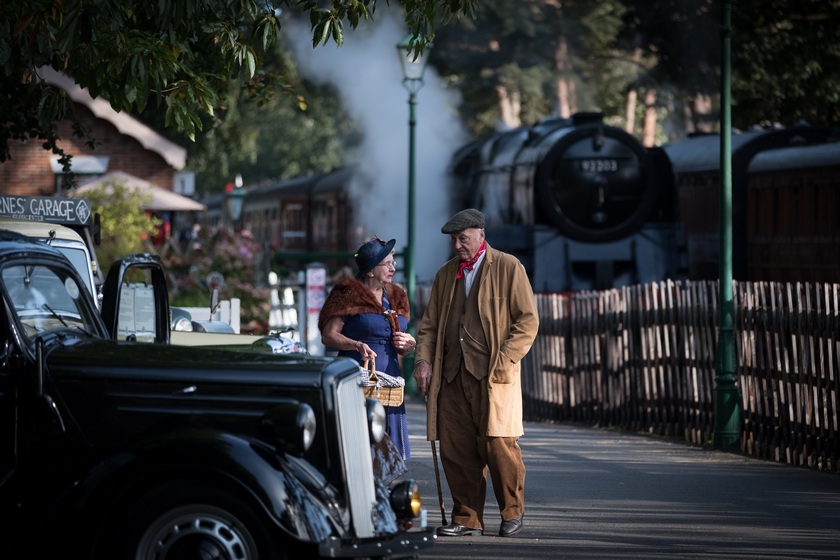
Fuji X-T2 50-140mm at 140mm f2.8
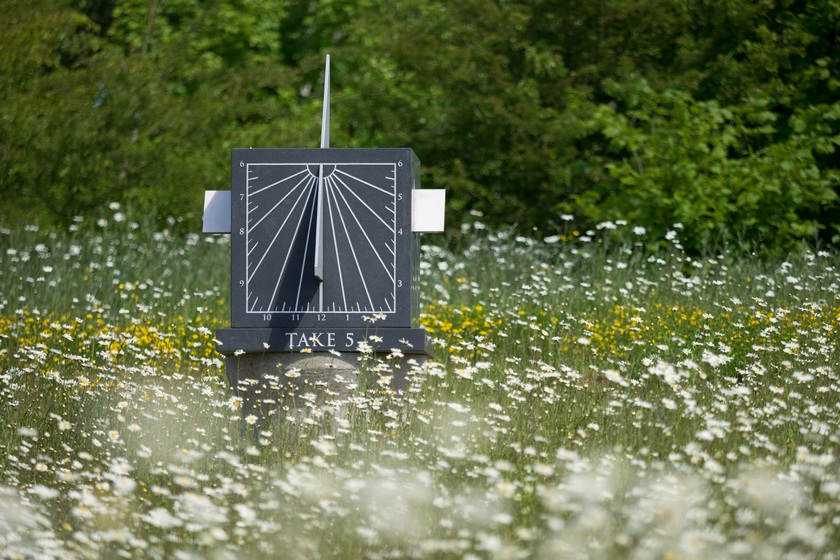
Olympus E-M1 40-150mm at 135mm f2.8 (a little busy in the background)
It is sometimes the subtleties of lens performance that make or break a lens to my mind, such as bokeh and flair, rather than outright sharpness. I have generally found the Fuji lenses to be good although rarely exceptional. Although saying that the 50-140mm f2.8 is exceptional. I see no degradation shooting it on an X-T2 compared to shooting the Nikon 70-200mm f4 on the D750. The image stabilisation is exceptional on the Fuji as well, although the Nikon lens is no slouch in that regard. I’ve heard a lot of people rave about the Fuji 35mm f1.4 (full frame equivalent 52.5mm f2.1) but it’s no better than the Nikon 50mm f1.8, slightly less sharp I’d say, and over twice the price. If you really wanted a 50mm f1.8 equivalent on the Olympus system then you’d be looking at the Olympus 25mm f1.2 Pro lens (FF 50mm f2.4) of the Voigtlander 25mm f0.95 (FF 50mm f1.9) manual focus lens. Both of which cost very roughly £1000. So, if you need that specific focal length and aperture you might want to think carefully about which system you choose. As a point of note, both the Voigtlander and Olympus 25mm lenses weigh more than the Nikon 50mm f1.8 lens too. So, shooting with a smaller camera may not in all cases save you size and weight on lenses.
I’ve shown a table below showing lenses of approximately similar functionality and what their full frame equivalence is and also their weight. They may not be equivalent in terms of image quality.
| System | Lens | Fx Focal Length | Fx Aperture | Cost | Weight |
|---|---|---|---|---|---|
| Nikon | 50mm AF-S f1.8 | 50mm | f1.8 | £149 | 185g |
| Fuji | 35mm f14 | 52mm | f2.1 | £469 | 187g |
| Olympus | 25mm f1.2 | 50mm | f2.4 | £888 | 410g |
| Nikon | 70-300mm AF-P f4.5 to f5.6 | 70-300mm | f4.5 to f5.6 | £524 | 680g |
| Fuji | 55-200mm f3.5 to f4.8 | 82-300mm | f5.2 to f7.2 | £624 | 580g |
| Olympus | 40-150mm f2.8 | 80-300mm | f5.6 | £1200 | 760g |
| Nikon | 24-70mm VR f2.8 | 24-70mm | f2.8 | £1670 | 1070g |
| Fuji | 18-55mm f2.8 to f4.0 | 27-82mm | f4.2 to f6 | £550 | 310g |
| Olympus | 12-40mm f2.8 | 24-80mm | f5.6 | £650 | 382g |
I can imagine the veins bulging in the necks of the Olympus fans here because I dare to compare the Olympus 40-150mm f2.8 Pro to the lowly Nikon 70-300mm f5.6 or indeed the Fuji 55-200mm lens. But the Nikon is a direct equivalent and frankly will probably deliver much the same sharpness on a full frame sensor that the Olympus lens does onto a M43 sensor. The Fuji lens is a little slower at f7.2 at 300mm but is a little faster at f5.2 at 82mm. The Olympus lens probably is slightly sharpener than the Fuji but then again it's twice the price! It's also somewhat heavier. I think what this shows is that M43 might, or might not, save you weight but it's unlikely to save you money.
So there’s not as much difference in weight between full frame, Fuji crop sensor and Olympus M43 as you might think when you look at directly equivalent lenses. I know what you’re thinking, these lenses aren’t equivalent at all as the Olympus Pro lenses are of a higher quality than say the Fuji lenses. That would be an interesting test to run because I suspect in real world terms there’s actually very little difference between them. Fuji has the upper hand over Olympus in that it’s easier to achieve higher resolution with a larger sensor than with a small one. But to give credit to Olympus their Pro lenses are very sharp and do tend to maintain that sharpness across the frame a bit better the Fuji lenses and indeed better than Nikon. The bigger the sensor, generally, the more likelihood of quality dropping off towards the edge of the frame. Certainly the Olympus 12-40mm f2.8 Pro is more consistent across the frame than the Nikon 24-120mm f4 but the D750 is higher resolution and achieves that resolution more easily in the centre of the frame. Trying to achieve 24MP of resolution on the X-T2’s crop sensor would equate to 54MP on a full frame sensor, which is pretty challenging. Likewise, 20MP on a M43 sensor equates to around 77MP on a full frame sensor! There aren’t many full frame lenses that would achieve that across the frame, by which I mean no full frame lenses achieve that across the frame! I guess it's possible the new Nikon Z lenses may improve corner to corner sharpness on full frame, we'll have to wait and see.
In favour of Olympus, I would say that their Pro lenses generally achieve better corner to corner sharpness than either Nikon or Fuji do. The but is that both Nikon and Fuji have higher resolution sensors so they're less forgiving of corner sharpness fall off. It would be really interesting to see a proper resolution test performed on all the Olympus Pro lenses, at f4, in HiRes mode to see what they're really capable of. If this were done I can pretty much guarantee you'd see significant sharpness deterioration in the image corners.
I think what this shows is largely what I said earlier, that the resolution of modern day cameras has become ridiculously high and is no longer useful to most people especially not amateur photographers. But we're told to think it is important by the marketeers so we buy newer cameras! I think this is one of the reasons M43 cameras have become popular, no they’re not the best in terms of image quality and dynamic range, but they are good enough for most purposes and being smaller and lighter they can be more fun to use.

Nikon D750

Nikon D750
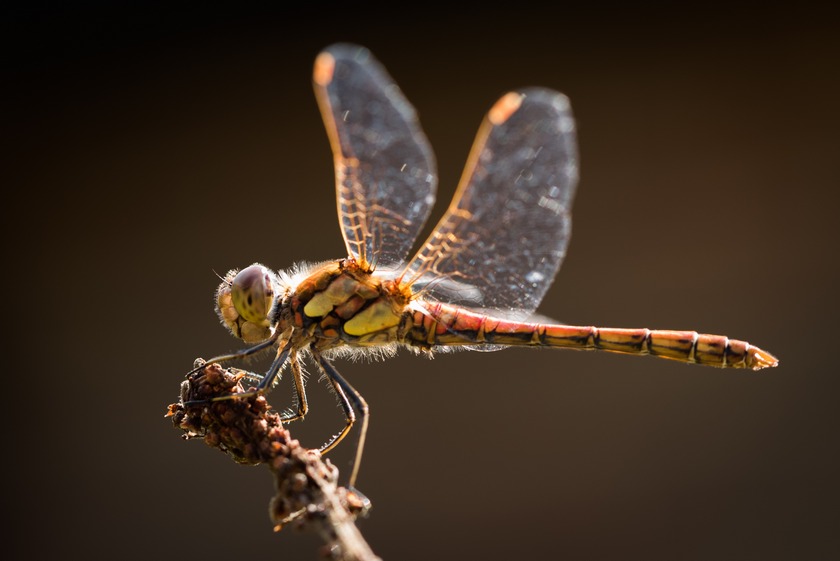
Nikon D750

Nikon D750

Nikon D750
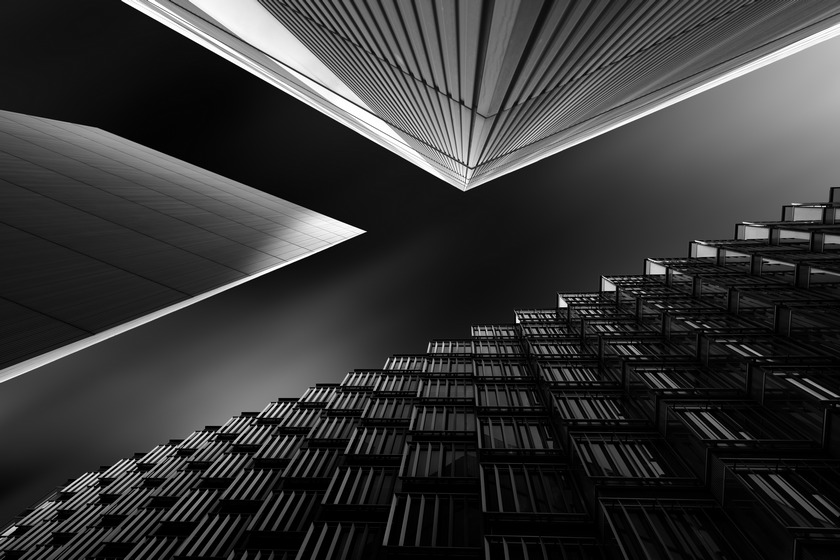
Nikon D750

Nikon D750
The Fuji X-T2, Fuji 14mm f2.8, Fuji 18-55mm and Fuji 55-200mm kit is relatively light weight (1630g) and will give you very good image quality. In my opinion the lesser Olympus and Panasonic lenses don't really cut it so if you wanted to equal this focal length range and quality with an Olympus setup, in my opinion, you'd have to buy the pro lenses to keep up so you'd be looking at the 12-40mm f2.8, the 40-150mm f2.8 and you'd still have to add a wide angle lens, such as the Panasonic 8-18mm, to get you to around 20mm full frame equivalent. By the time you've done that you'll be looking at a heavier (2080g), bulkier and more expensive setup than the Fuji kit I suggested. So you'll be paying more and having to carry more weight than you would with the Fuji. Some people may disagree that you need to buy Olympus Pro lenses to equal the Fuji standard lenses but it's my opinion that you do. I've been very underwhelmed with any Olympus or Panasonic run of the mill lenses that I've used and frankly think they fall well sort of the excellent Fuji 18-55mm and 55-200mm lenses.
I think this is a perfect example that when you buy into a system it's more to do with what lenses are available than the actual camera itself. This really is something to think about, make sure you consider the whole ecosystem that goes with a given camera before deciding on which is best for you. One thing that annoys the hell out of me about the M43 system is than neither Panasonic or Olympus make a decent 10mm ish prime. Personally, I've gone right off ultra wide angle zooms. I feel that anything wider than 18mm full frame is such a specialist lens that it's virtually as niche as a fish eye lens, and almost as difficult to use well. For me an 18mm to 20mm prime is perfect for those occasions when you need something a bit wider than either 24mm or 27mm. I used to own the Nikon 16-35mm lens and I sold it because I didn't like it. It wasn't that sharp, especially in the corners, and it was way too big, too heavy and too expensive. The Nikon 20mm f1.8 is far better, far smaller and is 2 stops faster should you need that. Likewise, the Fuji 14mm f2.8 is a lovely little lens, it's small, it's light, at around 300g, and has very good image quality.
One further gripe I have with both Fuji and Olympus is that their base ISO is 200. Why can't they do the same as Nikon on their crop sensor bodies and have a real base ISO of 100? This would add another stop of dynamic range and therefore greater image pullability in post processing and on the M43 body would mean that you would have virtually no noise at base ISO. C'est la vie, just one of the trials of life I guess.

Fuji X-T1
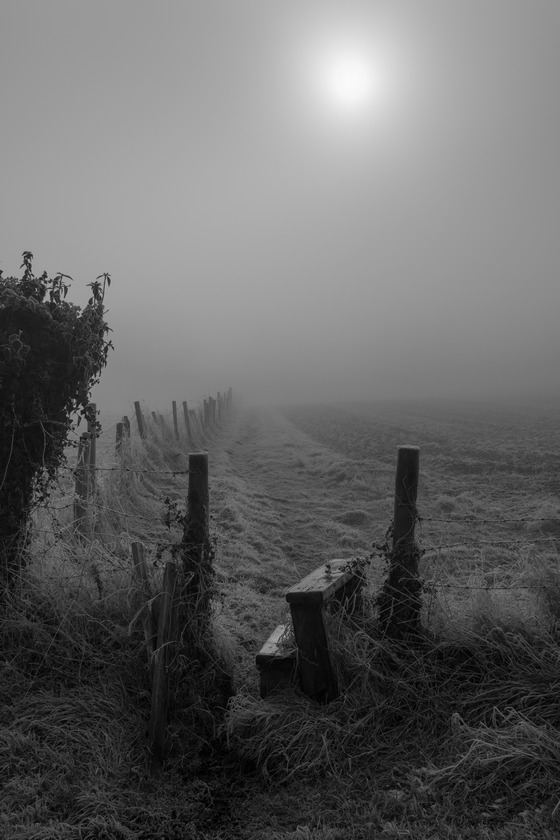
Fuji X-T1

Fuji X-T1
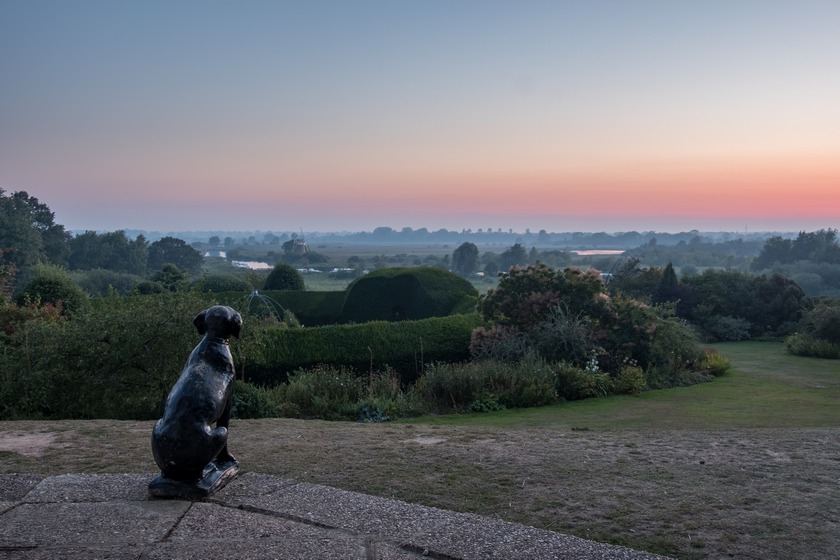
Fuji X-T2
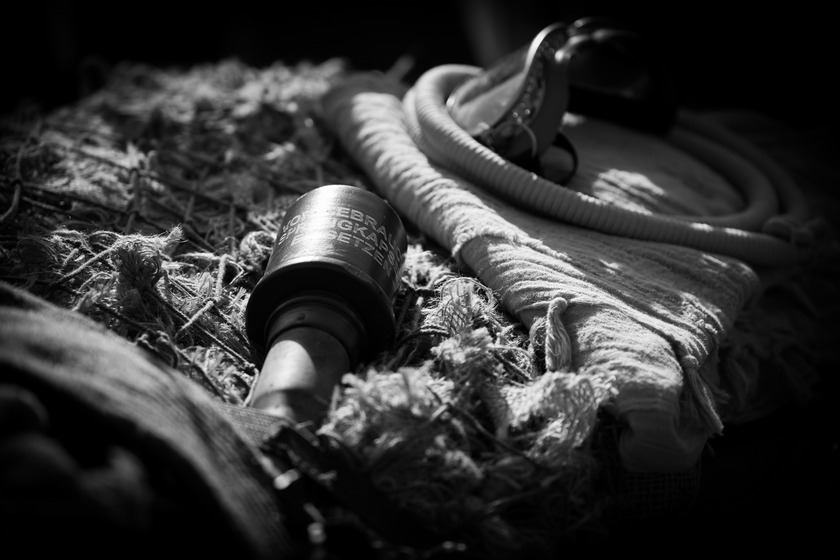
Fuji X-T2
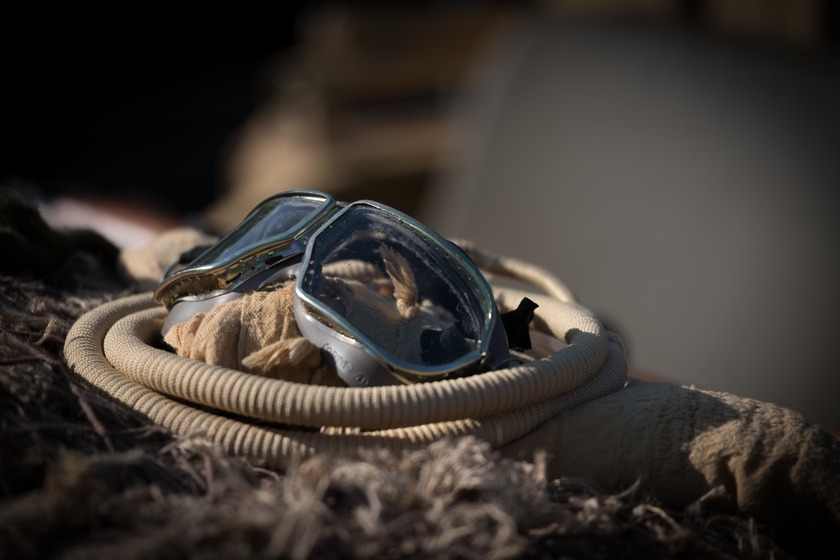
Fuji X-T2
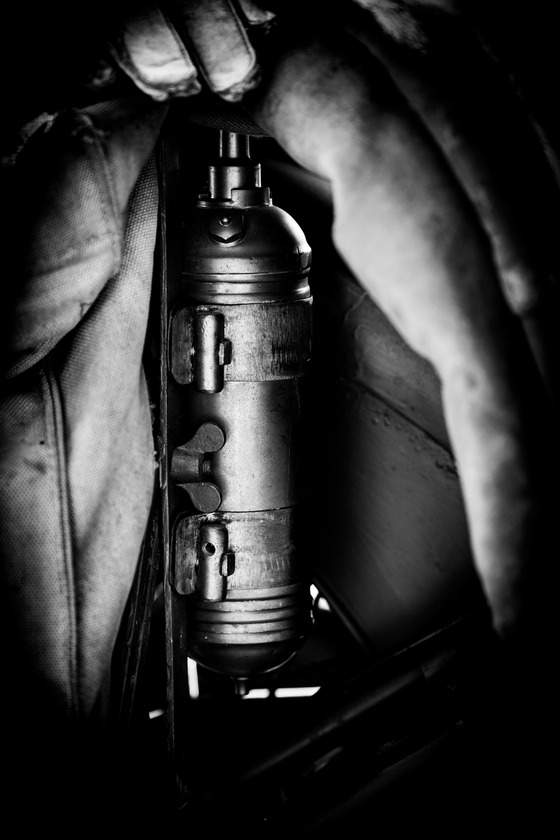
Fuji X-T2
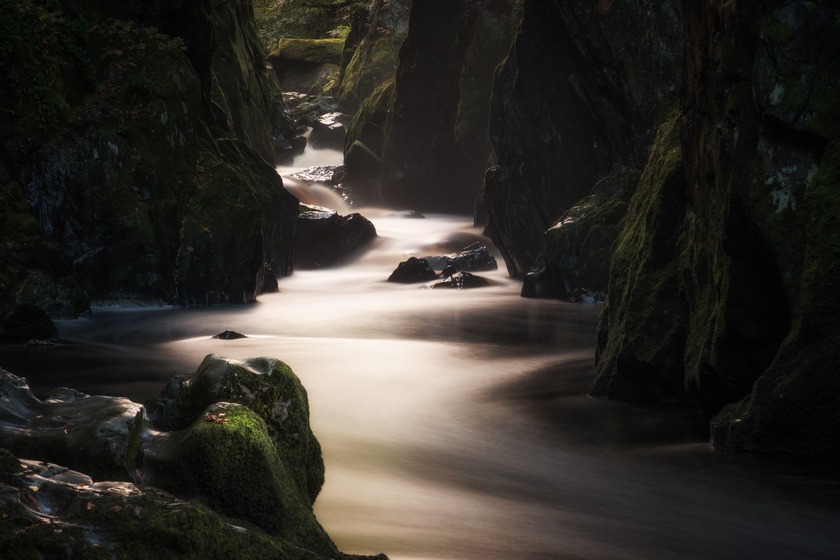
Fuji X-T2

Fuji X-T2

Fuji X-T2
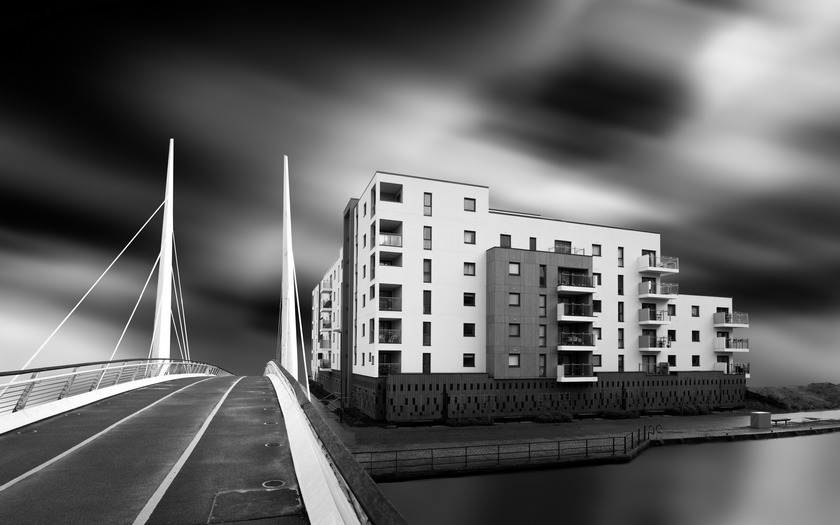
Fuji X-T1
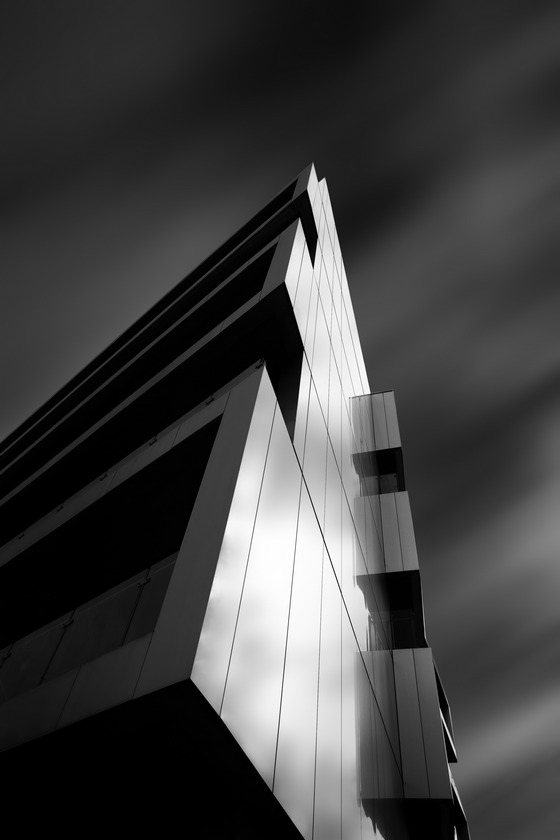
Fuji X-T1
If I could only have one of these cameras it would reluctantly be the Olympus E-M1 for the simple reason that it allows me to take macro photos in a way that I cannot with either of my other cameras. But I would be loath to always have to settle for the much reduced dynamic range that the smaller sensor gives. And I would resent having to carry the extra weight too. Talking of macro it’s worth noting that if I did want to use my X-T2 for macro photography down to 1:1 (24mm across the sensor) I’d have to buy the outrageously expensive Fuji 80mm macro lens for over £1000! My second-hand E-M1 and Olympus 60mm macro lens cost notably less than that. This can be an issue with the Fuji system, equivalent lenses can, on occasion, be much more expensive and if you want auto focus there’s virtually no other choice. And yes I do know that Zeiss make the 50mm f2.8 macro lens in Fuji X-mount which is at least a little cheaper than the Fuji offering.

Olympus E-M1 60mm

Olympus E-M1 12-40mm

Olympus E-M1 12-40mm

Olympus E-M1 60mm

Olympus E-M1 60mm

Olympus E-M1 12-40mm

Olympus E-M1 12-40mm

Olympus E-M1 60mm

Olympus E-M1 60mm

Olympus E-M1 60mm

Olympus E-M1 60mm

Olympus E-M1 60mm

Olympus E-M1 60mm

Olympus E-M1 60mm

Olympus E-M1 60mm

Olympus E-M1 60mm
I haven't really said much about the specific benefits of mirrorless cameras. Personally, I'm sold on them for various reasons. I did mention how much easier they are to use with an ND1000 filter. Another significant benefit for me, as I'm slightly long sighted, is that I can preview images in the viewfinder without having to wear glasses. This is even more relevant on sunny days when you can't see a thing on your rear display. Having a live histogram in the viewfinder is really useful too, I didn't realise just how much so until I went back to my Nikon and realised I always take at least two shots of any landscape, one to see what the camera's metering gives me and a second photo with exposure compensation to correct it. I don't have to do that with a mirrorless camera because I have a histogram to tell me what the correct exposure is before pressing the shutter release. Another benefit is manual focusing on mirrorless systems is a lot easier than on dSLRs. Given focus peaking and the ability to zoom in in the viewfinder it makes for a pretty good experience even with very fast lenses. A final comment is I like having a level in the viewfinder, it means a little less straightening to do in post processing.
For static subjects I also prefer the sensor based focusing on mirrorless cameras. On Olympus it's lightening quick, I'd say faster than the D750, although that is of course dependent on what lens you're using on any system. To give credit to Olympus their Pro lenses are all very fast. Some of the older Fuji primes can be a bit noisy and slow in comparison. I don't think either the X-T2 and certainly not the E-M1 mki are up there with the likes of the Nikon D500 for focus tracking but I think the X-T2 and X-T3 are getting there. Possibly the E-M1 mkii as well.
If I didn't do macro photography I'd opt for the Fuji system because it's lighter than the Olympus system with Pro lenses but would miss certain attributes of the Olympus E-M1, mainly the amazing IBIS.
By the way, if you are tempted by M43 then I would say buy yourself a second-hand E-M1. It's an amazing camera, which fits my hands far better than the smaller OM-D cameras, and is an absolute steal nowadays second-hand. I'm not sure the E-M1 MKII brings that much to the party really unless you really need better focus tracking. I know it adds HiRes but if I'm honest I think that's mostly a gimmick, as I said before, who really needs even more resolution?. And that damn twizzling rear screen on the E-M1 MKII turns me right off! I use Arca Swiss l-brackets on all my cameras, particularly useful for macro photography, and that so called "fully articulating display" is a complete no go with an l-bracket. I much prefer the Fuji solution on the X-T2 and X-T3 where you can tilt the rear display in either orientation.
Equally, if you're tempted by the Fuji system, get a second-hand X-T1. They're ridiculously cheap nowadays as they've been superseded twice and they're still a really good camera.
I think what all of this shows is that if you want top end optics then you're unlikely to save any money by moving to Olympus or Fuji. They both charge top dollar for their high end lenses, especially Fuji because there's virtually no competition other than Samyang manual focus lenses which are generally superb if you can cope with manual focus. Likewise on the bodies, the E-M1 MKII and Fuji X-T3 are as expensive as a full frame body. So it really does come down to exactly what your requirements are as to which system works for you. In many situations there's no perceptible difference between full frame images, crop sensor images and M43 images. If you shoot JPEGs then I'd say don't bother with full frame because you're not going to see the advantages. For me, it's the 'pullability' of the files in post processing that really stands out with full frame and you have to shoot RAW to access that ability.
What I would say, to put things in perspective, is in the over all scheme of things, all of these cameras are amazing. It's easy to pick holes in modern day kit but the reality is most high end, modern day cameras are fantastic tools and we're lucky to have them. Also bear in mind that the Olympus E-M1 MKI is 6 years old at the time I'm writing this, the Fuji X-T1 is over 5 years old, the D750 is 5 years old and they're all still highly capable cameras. I think the speed of progress is gradually slowing with camera updates nowadays which does mean you can get some great bargains if you don't feel you have to have the latest and greatest. I think the main area where mirrorless cameras are moving forward, and rapidly catching up with the best of dSLRs, is focus tracking with moving subjects.
So the executive summary is use what works for you and stop worrying about what’s better. A decent photographer can take better photos with a mobile phone than a poor photographer can with a medium format Phase One body. That obviously doesn’t hold true for sport, wildlife and macro photography where we have very specific requirements that have to be met by our cameras. I don’t really do the first two and I bought an E-M1 to do the latter so read into that what you will.
So, let me list the pros and cons of each system for my use case. This of course may be wildly different for someone else because their needs maybe very different to mine.
Olympus EM1 MKI Pros
Olympus E-M1 MKI Cons
Fuji X-T2 Pros
Fuji X-T2 Cons
Nikon D750 Pros
Nikon D750 Cons
By trade I’m an electronics design engineer hence the quite technical nature of this review. I like to know exactly what a product delivers so I know how I can rely on it and how I can use it. I hope this review is of assistance to anyone who is considering buying into one or another of these camera systems